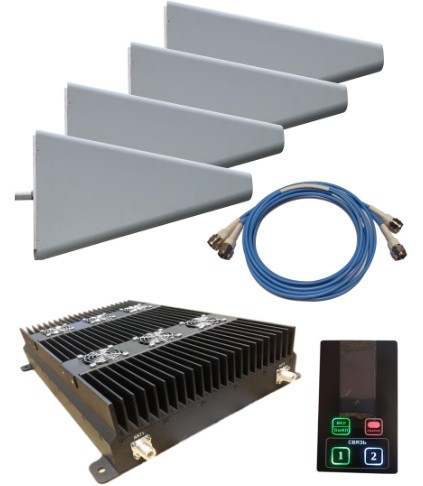Perseus-202
The device is designed for protection of VIPs, convoys and secured areas against threats of possible terroristic acts performed using small UAVs (drones).
Protection is implemented via blocking radio data transmission lines of unmanned aerial vehicles and jamming receivers of satellite radio navigation systems.
| Frequency ranges |


|
GNSS channels: 1164…1300; 1559…1610 MHz Data transmission channels: 2400…2500; 5150…5875 MHz |
| Integral output power |


|
140 W |
The principle of operation consists in generation of interference signals with a special time-frequency structure, their amplification and radiation to a given sector of space. Interference signals for blocking radio data transmission lines are generated in two frequency ranges: from 2400 MHz to 2500 MHz and from 5150 MHz to 5875 MHz, covering the operating frequencies of the vast majority of radio data transmission lines used in small UAVs (drones). Signals for jamming receivers of satellite radio navigation systems are formed in two frequency ranges: from 1164 to 1300 MHz and from 1559 to 1610 MHz, corresponding to the operating frequency ranges of 4 global navigation satellite systems (GPS, GLONASS, Galileo, BeiDou).
Interference signals are similar in their time-frequency structure to signals used for radio navigation and for data transmission between the operator and the UAV, which makes it possible to increase the efficiency of jamming and improve the effective range. To further improve efficiency, “Perseus-202” uses an antenna system that concentrates interference signals in a beam with a width of 45 degrees in azimuth and 70 degrees in the elevation, and continuously steers this beam through an assigned sector. Maximum width of the radiation sector is 180 degrees. Depending on the application the sector can be narrowed by mechanically rotating the antennas. Due to the high speed of signal switching between the antennas (1-10 ms), quasi-continuous exposure of the space is achieved. Switching is carried out automatically.
Switching on and setting operating modes is carried out using a remote-control unit connected to the main unit via a cable with a maximum length of 30 meters. The remote-control unit is equipped with an LCD screen for displaying information about the current state and malfunction indication.
Having a relatively small weight and dimensions, “Perseus-202” can be placed on the roofs of buildings, radio communication towers and vehicles. The main unit can be located in a convenient place for inspection, and the antenna system does not need constant maintenance.
Special features
- jamming of all 4 global SRNS receivers
- suppression of drone control channels in a wide frequency range
- flexible management of the protected area sector
- high total radiated power (140 W)
- designed for harsh environment antenna system
- simple control system with user-friendly interface
- built-in digital diagnostics system with alarm about malfunction
- construction meets military standards requirements

Technical specifications
| Frequency ranges | GNSS channels: 1164…1300; 1559…1610 MHz Data transmission channels: 2400…2500; 5150…5875 MHz |
| Integral output power | 140 W |
| Power supply | AC, 50 (60) Hz 230 (240) V DC 12 or 24 V |
| Forming of jamming signal | GNSS channels PSK (BPSK, BOC, CBOC) with frequency and code division multiplexing; data transmission channels LFM (chirp); PSK (BPSK, QPSK), QAM with orthogonal frequency division multiplexing |
| Consumed power in jamming mode | 700 W |
| Dimensions | Antenna system Ø1680 mm, main unit 530 × 370 × 105 mm, power supply unit 350 × 150 × 80 mm |
| Mass | Main unit 20 kg, power supply unit not more than 2,5 kg, antenna system not more than 28 kg |

